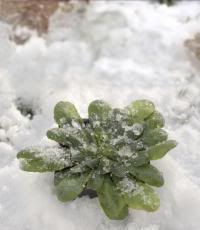How plants cope with climate change
 Growing plants and biomass for the production of low carbon energy may well be a viable strategy to mitigate global warming, but how do plants themselves adapt to rapid climate change? Scientists studying how plants have naturally evolved to cope with the changing seasons of temperate climates have discovered a first answer to that question. It could help us to breed new varieties of crops, able to thrive in a changing climate.
Growing plants and biomass for the production of low carbon energy may well be a viable strategy to mitigate global warming, but how do plants themselves adapt to rapid climate change? Scientists studying how plants have naturally evolved to cope with the changing seasons of temperate climates have discovered a first answer to that question. It could help us to breed new varieties of crops, able to thrive in a changing climate.The importance of the discovery is that it reveals how a species has developed different responses to different climates in a short period of time.
Researchers at the John Innes Centre (JIC), Norwich, UK have been examining how plants use the cold of winter to time their flowering for the relative warmth of spring. This process, called vernalization, varies even within the same plant species, depending on local climate. In Scandinavia, where winter temperatures can vary widely, the model plant, Arabidopsis has a slow vernalization response to prevent plants from being 'fooled' into flowering by a short mid-winter thaw. One particular gene, named FLC, delays flowering over the winter and the research team discovered how cold turns off FLC and what keeps it off during growth in spring. In the UK plants only need four weeks of cold to stably inactivate FLC, allowing plants to start their spring flowering early. Arabidopsis plants in Sweden have a mechanism that requires 14 straight weeks of winter cold before FLC is stably inactivated. This prevents the plants flowering only to be hit with another month of harsh winter weather:
"It looks like the variation in this mechanism to adapt the timing of flowering to different winter conditions has evolved extremely quickly. We hope that by understanding how plants have adapted to different climates it will give us a head-start in breeding crops able to cope with global warming." -- Research leader at JIC, Professor Caroline Dean.Dean says the team studied levels of the FLC gene in Arabidopsis plants (picture) from different parts of the world expecting to find regional variations that correlated with how much cold was required to switch FLC off. It discovered that FLC levels in autumn and the rate of reduction during the early phases of cold were quite similar in Arabidopsis plants from Edinburgh and N. Scandinavia . However, the scientists found big variations in how much cold was required to achieve stable inactivation of FLC. FLC was stably silenced much faster in Edinburgh than it was in N. Scandinavia and a genetic analysis showed that differences in the FLC gene itself contributed to this variation:
 biomass :: bioenergy :: biofuels :: energy :: sustainability :: agriculture :: climate change :: adaptation :: biology :: plant sciences :: plant genetics :: biotechnology ::
biomass :: bioenergy :: biofuels :: energy :: sustainability :: agriculture :: climate change :: adaptation :: biology :: plant sciences :: plant genetics :: biotechnology ::The JIC scientists worked in collaboration with a team at the University of Southern California and were funded by the UK's main public funders of biological and environmental sciences, the Biotechnology and Biological Sciences Research Council (BBSRC) and the Natural Environment Research Council.
Professor Julia Goodfellow, BBSRC Chief Executive, commented: "As well as working to prevent climate change we need to be able to harness natural methods to adapt food crops to cope with changed and hostile climates around the world. This is an example of how basic science can make a practical difference."
From temperate climates to the tropics
The research focused on plants growing in temperate climates only. However, other scientists are looking at the same issue for species that thrive in the tropics and subtropics - the places where food security is far more fragile.
Eearlier we pointed to a large initiative launched by the Consultative Group on International Agricultural Research (CGIAR) in consultation with the global environmental change science community, which is aimed at refining a comprehensive climate change agenda that is already generating climate-resilient innovations, including crops bred to withstand heat, salt, waterlogging and drought, and more efficient farming techniques to help poor farmers better use increasingly scarce water and fragile soil.
Examples of this research focused on breeding climate-resilient crops include the development of a technology that helps scientists identify "stay-green" genes to help crops like sorghum and millet cheat the heat; Reducing plants' thirst at the molecular level; and fine-tuning a plant's internal clock - in this case sorghum - so that it can be adapted to variations in precipitation levels (earlier post).
The discovery of the mechanism on the climate change coping strategy of plants in temperate climates may inspire similar research on species in the South.
 -------------------
-------------------
 Spanish company Ferry Group is to invest €42/US$55.2 million in a project for the production of biomass fuel pellets in Bulgaria.
The 3-year project consists of establishing plantations of paulownia trees near the city of Tran. Paulownia is a fast-growing tree used for the commercial production of fuel pellets.
Spanish company Ferry Group is to invest €42/US$55.2 million in a project for the production of biomass fuel pellets in Bulgaria.
The 3-year project consists of establishing plantations of paulownia trees near the city of Tran. Paulownia is a fast-growing tree used for the commercial production of fuel pellets.









0 Comments:
Post a Comment
Links to this post:
Create a Link
<< Home